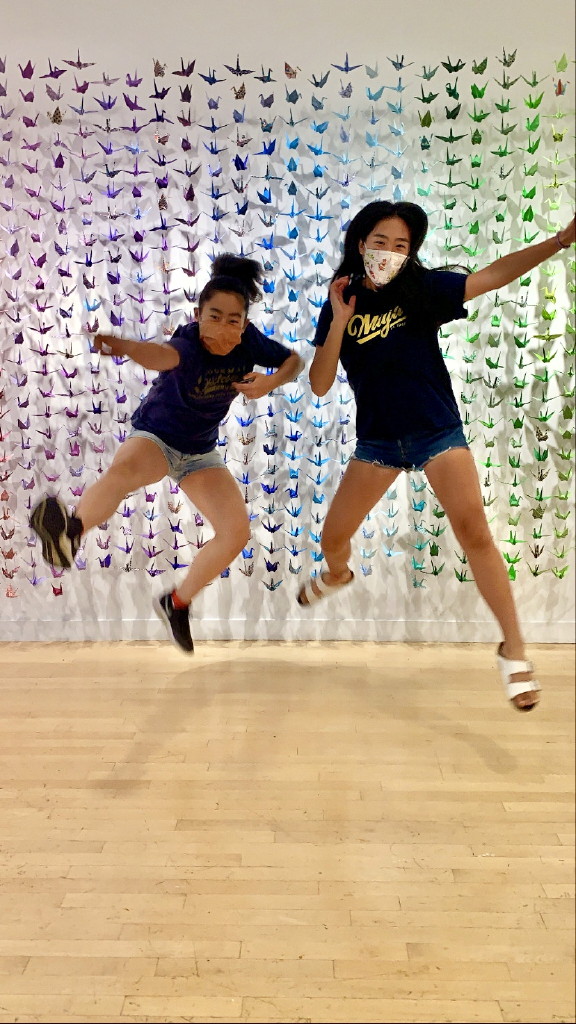By Pam Hersh
On Saturday afternoon, feeling a bit down under the COVID cloud, I closed my bag of Cheetos and decided to go to the Arts Council of Princeton’s Paul Robeson Center for the Arts to see some cranes: 17,857 cranes, to be exact.
Several weeks ago, when Princeton residents Heidi Moon and her three children (13-year-old Lois, 16-year-old Stella and 18-year-old Gwen Matsukawa) were feeling a bit “hopeless and helpless” under the COVID cloud, they decided to make some cranes.
In both my case and that of Ms. Moon, the cranes succeeded in puncturing the COVID cloud to allow some sunlight shine through. In Heidi’s case, however, her personal crane therapy snowballed into therapy for hundreds of others in the Princeton community.
Heidi and her husband Bob Matzukowa became an integral part of the Princeton community, when three years ago they opened Miya Table and Home in Palmer Square (featuring elegant, Japanese themed tableware), and, by doing so, expanded a renowned, multi-generational Matzukowa wholesale business into a retail sales world. Heidi, who has led origami classes in the store, conceived the Princeton Paper Crane Project as an origami exercise of hope and healing. In Japanese culture (Bob’s ancestors hail from Japan, Heidi was born in South Korea), the crane is a symbol of longevity and peace. Senbazuru (a thousand cranes) is a well-known tradition in Japan that promises fulfilled wishes to those who fold 1,000 cranes.
Miya and the Arts Council of Princeton, with support from Princeton’s well-known human rights activist Ross Wishnick, invited the community to participate by folding and donating paper cranes to this public art installation. Although I folded none of the paper cranes on exhibit and thus I got no wish fulfilled, I did get to revel in the simplistic beauty and exhilarating spirit of the exhibit and its message.
In the beginning of the COVID crisis, Heidi said she thought she would find satisfaction in spending some time reading and knitting – she had several books on her must-read list. “But, in spite of my personal goals and those of my family members, it didn’t take long for all of us to feel a bit hopeless and helpless,” she said.
The official numbers of people getting sick and dying seemed so impersonal, just data, and not reflecting the human element of this tragedy, said Heidi. The cranes would be a way to honor and give hope to those who were affected directly by the pandemic.
“What gave me comfort, honestly though, was making the cranes with my family. We would do it together, while talking or watching TV, and I found it quite therapeutic and soothing. We did hear that a lot from other people. Origami may feel challenging at first, but once you get a hang of it, it’s so satisfying. In a few minutes, you have a beautiful handcrafted piece of art made from just a square piece of paper,” she said.
Also very gratifying was the involvement of the community. Ross and Heidi, working with the Arts Council, got the word out through social media and fliers soliciting origami cranes. There were several dropoff boxes around town. Miya Table and Home, thanks to a successful rush order from Japan, was able to carry a supply of origami paper – just a six inch square of paper of any color. Origami creators were encouraged to draw a picture, write a name, or convey a message on their paper before creating their mini piece of art. Once the cranes were collected, there was the painstaking work of stringing the cranes together with little beads separating the cranes and then the “extremely challenging” work of hanging the clusters of cranes in the community exhibit space at the Arts Council. “Thankfully, Bob was particularly skilled, exacting, and patient at doing this,” said Heidi.
Heidi and her family are old hands (pun intended) at community origami projects. Last year when a white supremacist group threatened to demonstrate in Princeton, Heidi initiated a 1,000 cranes project to send a different message. Even though the demonstration was called off, the crane project had the effect of creating a positive vibe out of a very negative threat. The mini pieces of art were sold to raise money for the ACLU and for Princeton’s Cornerstone Community Kitchen (CCK) offering a free and nutritious meal every week.
When the current crane exhibit closes on Aug. 29, Heidi is trying to figure out a way to monetize the paper cranes and donate all the proceeds to a charity. Ideally, she said, would be a donation to cover the cost of installing mini-crane exhibits in the windows of all Princeton retail stores to celebrate community hope and healing.
A graduate of Cornell University with a degree in Asian/Asian American studies, Heidi and Bob, with a business management degree from NYU, never figured on the art of origami playing such an important role in their lives. But in times of stress and challenges, one never knows how things will unfold – or fold for that matter.
The Princeton Paper Crane Project will remain on exhibit through Aug. 29 at the Arts Council of Princeton, 102 Witherspoon St., Princeton 08542. For hours of operation, visit http://artscouncilofprinceton.org

